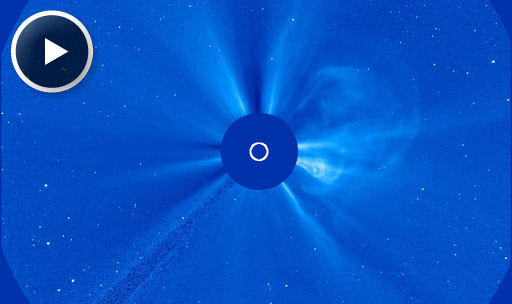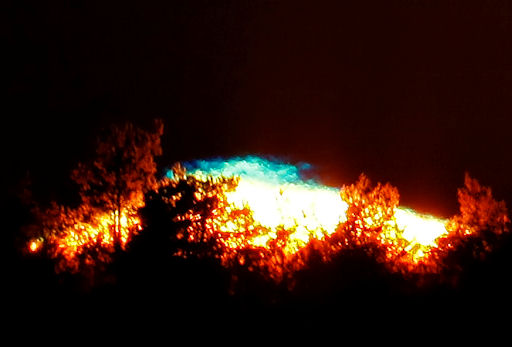Metallic photos of the sun by renowned photographer Greg Piepol bring together the best of art and science. Buy one or a whole set. They make a stellar gift. | | |
MAGNETIC DISTURBANCE UNDERWAY: A disturbance is rippling through Earth's polar magnetic field on March 1st. "The magnetometer needles are swinging here in Norway," reports Rob Stammes of the Polar Light Center in Lofoten. Bright auroras have been sighted in Sweden and Finland. Images: #1, #2, #3.
FARSIDE EXPLOSIONS: The Earthside of the sun is quiet, but the other side is not. On Feb. 29th, a farside sunspot erupted multiple times, hurling three CMEs over the sun's western limb. The Solar and Heliospheric Observatory recorded the expanding clouds:

The odds of more farside eruptions today seem high. The odds of Earthside eruptions, however, are just the opposite. NOAA forecasters say the chances of M- and X-class solar flares are no more than 1%. Solar flare alerts: text, phone.
BLUE FLASH: We've all heard of the green flash, the fleeting emerald light that sometimes appears just above the setting sun. Once thought to be a fable, the green flash was popularized by Jules Verne in his 1882 novel "Le Rayon Vert" (The Green Ray). Now it is generally known to be real.
But what of the even rarer blue flash? Turns out, that's real too. Peter Rosén photographed one from Stockholm, Sweden, on Feb. 29th:

"I was shooting the sunset when, suddenly, just as the sun was about to disappear behind the treetops, there was a mighty blue flash," says Rosén.
Blues flashes are formed in the same way as green flashes: a mirage magnifies tiny differences in the atmospheric refraction of red, green and blue light. Blue flashes are generally harder to see than green flashes, because blue flashes blend into the surrounding blue sky. When the air is exceptionally clear, however, the blue flash emerges.
Verne described the green flash as something "which no artist could ever obtain on his palette, a green of which neither the varied tints of vegetation nor the shades of the most limpid sea could ever produce the like! If there is a green in Paradise, it cannot be but of this shade, which most surely is the true green of Hope."
Ditto the blue.
February 2012 Aurora Gallery
[previous Februaries: 2011, 2010, 2009, 2008, 2007, 2006, 2004, 2003, 2002]

